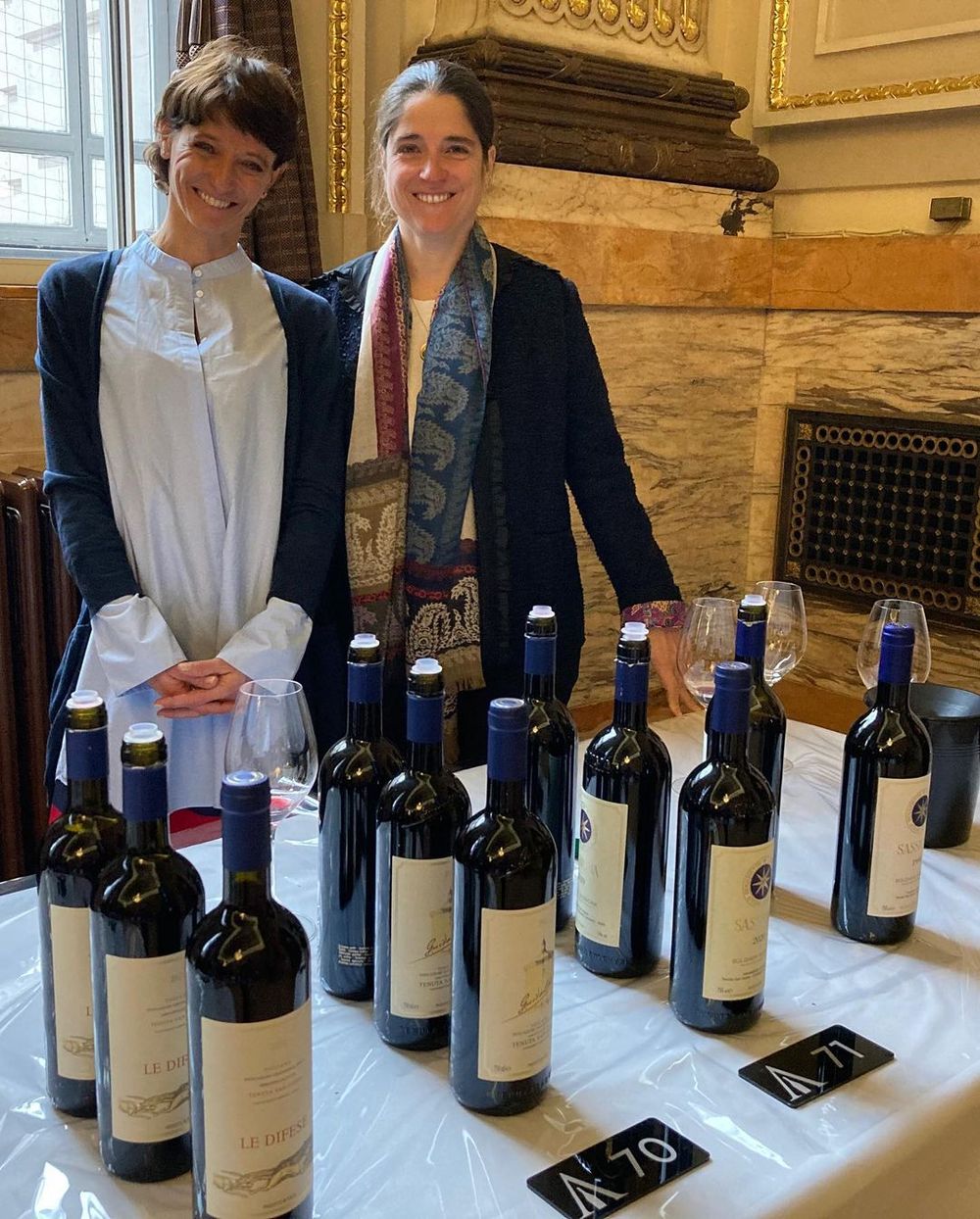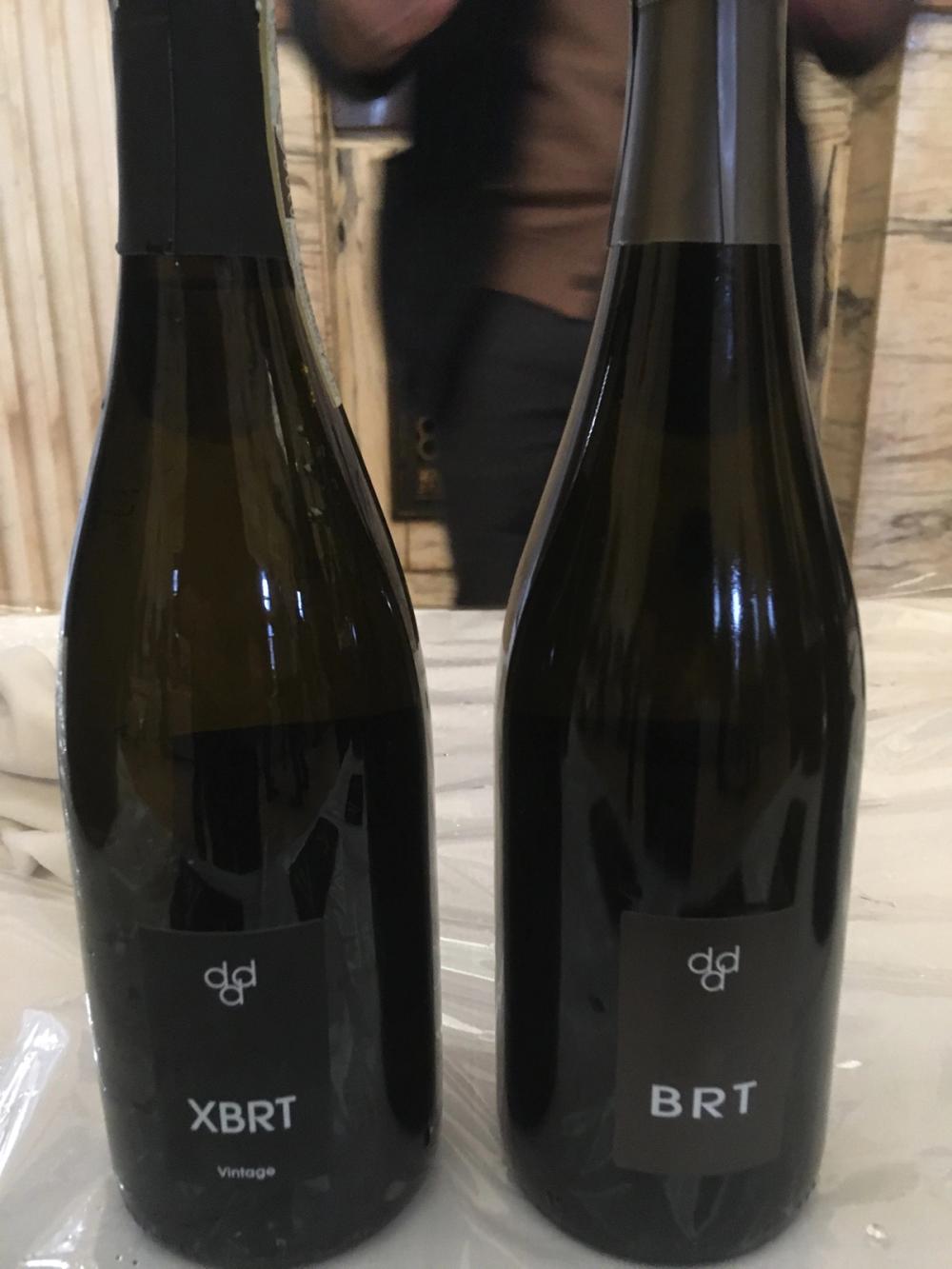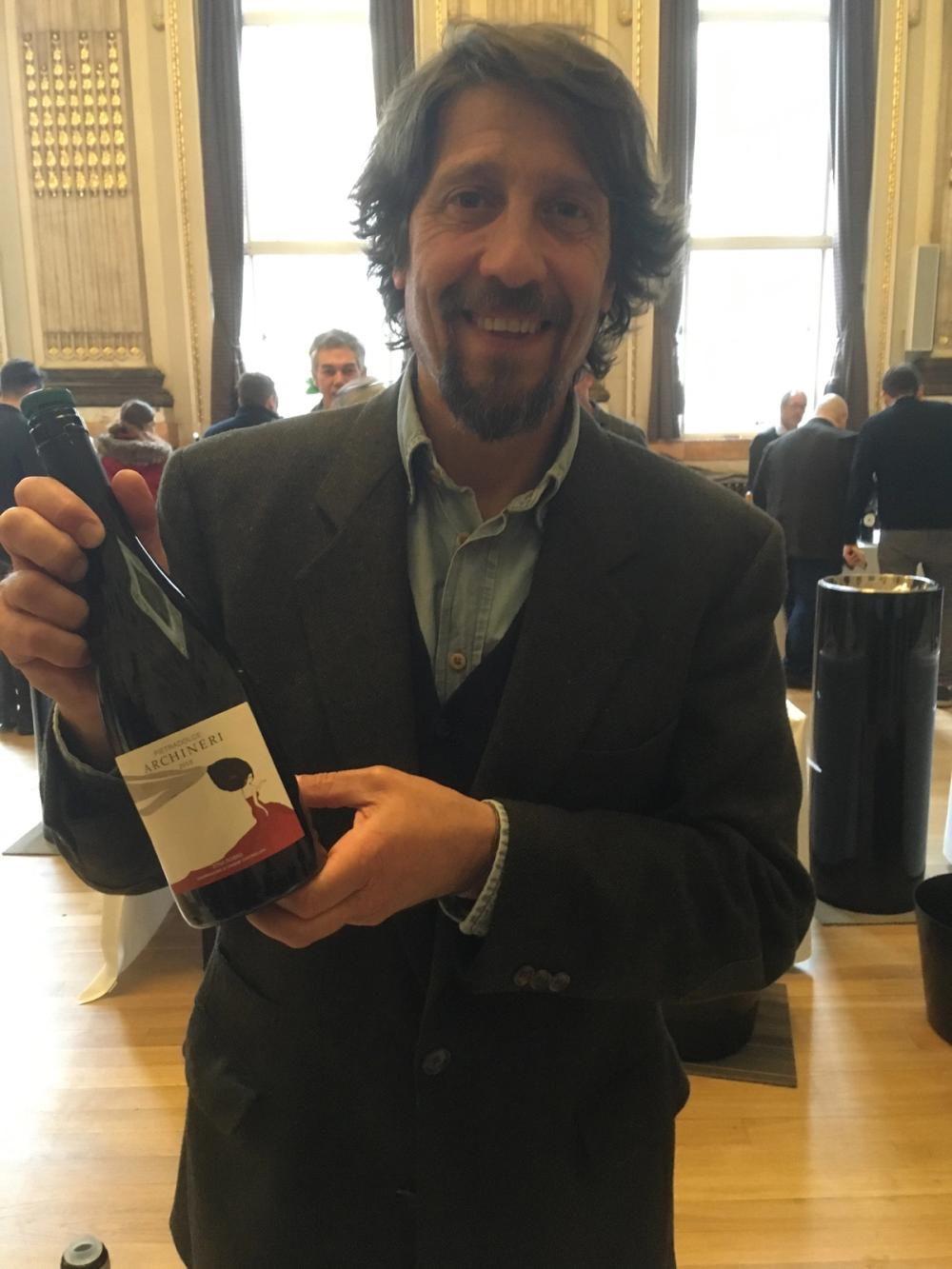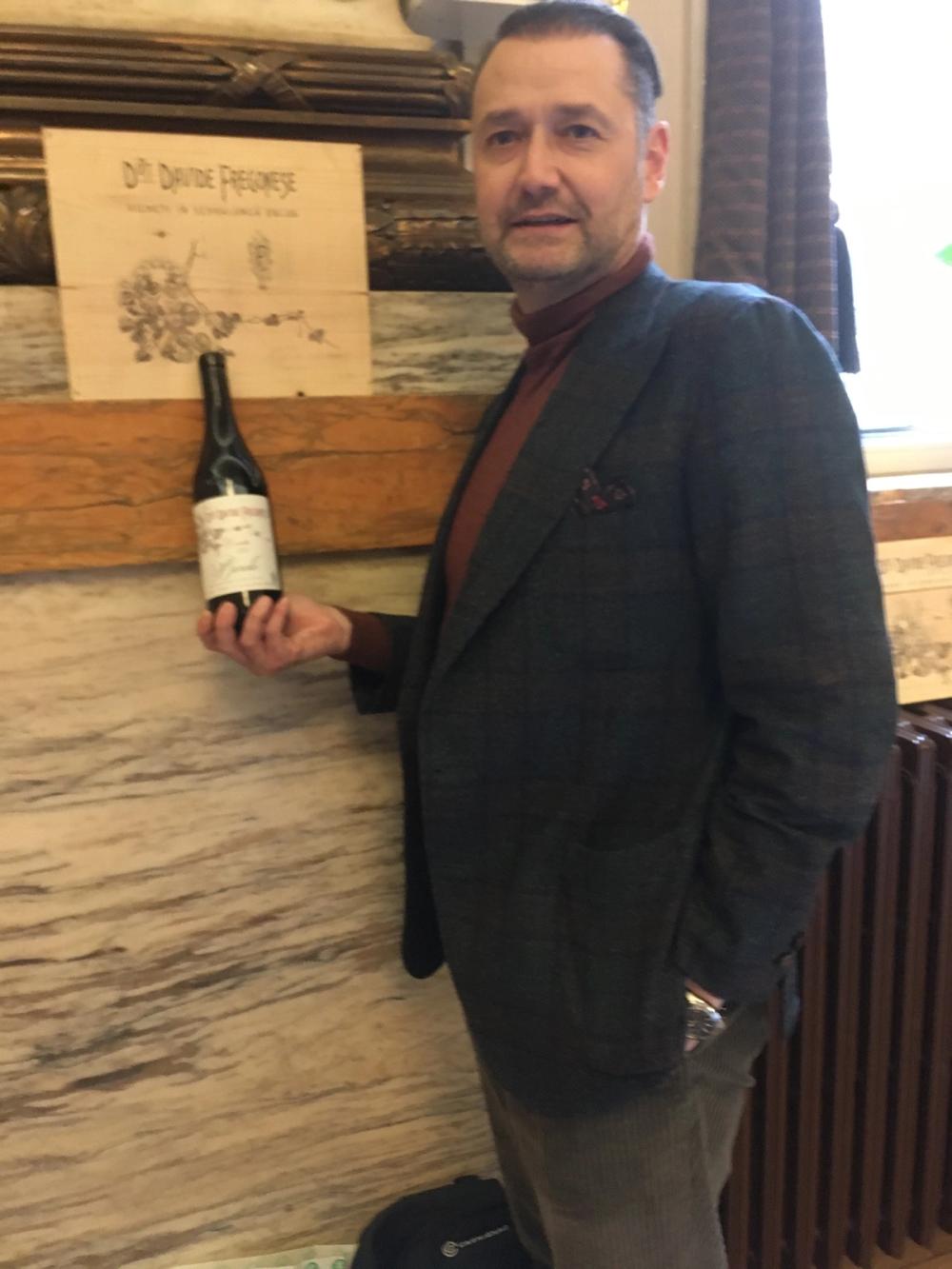“One take-away from this tasting is that the 2019 vintage – again, pretty much across the country – being shown here by many producers is shaping up as a great one,” writes Keay.

Team Tenuta San Guido, Armit Italy tasting, March 8, 2023
Armit Wines’ Italy range has long been the envy of its competitors and its 2023 Italy tasting – held in the usual salubrious surroundings of 1 Great George Street – was a great opportunity to remind myself why. The names read like a checklist of really great Italian wine – Sesti from Montalcino, Musella from Veneto, Bruno Giacosa and Giacomo Fenocchio from Piedmont, Tua Rita, Michele Satta, Querciabella and Tenuta San Guido from Tuscany…the list really does seem to go on and on. And it takes in the country so completely it would make Garibaldi proud, with producers from Piedmont and Liguria in the north right down through Abruzzo to Campania, Puglia, Sicily and across to Sardinia. There’s even Elena Walch from Alto Adige, a region under firm Hapsburg control when the Risorgimento was underway.
“Italy’s been good to us,” says Brett Fleming, as I hovered near the gaggle of tasters trying to get at the Sassicaia Bolgheri 2020 and the even more impressive Sassicaia Bolgheri 2012, shown in magnum – a new innovation for this tasting, with many producers taking the opportunity to showcase in magnum or regular bottles how well their wines evolve a few years down the road from the current vintages they are showing. And actually really important; as anyone familiar with new vintage Sangiovese will attest, certain varieties really do need time to show their true magnificent selves.
“Italy also hasn’t had the price increases that certain regions of France in particular have been putting through. I see it becoming increasingly important to us,” says Fleming, arguing it has played a role in the group’s improved overall performance, with EBITDA figures to be released soon.
“Our recovery’s well on track, particularly in the on-trade and for private clients; premium retail has taken a step back but that was to be expected post-Covid. That said, I think this is going to be a tough year for the on-trade, not helped by a government that doesn’t seem to know what’s it doing and just won’t listen.”
Fleming didn’t get any argument from me about the most inept and self-serving government in living memory – as we were speaking it was trying to persuade Parliament, just across the road from this tasting, of the dubious merits of its wretched, unworkable and probably illegal new asylum bill – but I digress it was time to see what stood out from this great range.
Highlights from the tasting

First off a new agency, Veneto’s duca di dolle. This impressive Conegliano Valdobiaddene producer goes someway to fill the sparkling wine hole in the portfolio (sadly, still no Franciacorta or Trento-Doc) and does so with some lovely wines, including a Rosé, made with 100% Pinot Noir, a NV BRT Prosecco Superiore DOCG and my personal favourite, the XBRT Rive di Rolle DOCG, very elegant with suggestions of pear and quince, quite dry (3.5g r/s versus 8 g r/s for the Brut). But to call these wines Prosecco is misleading – with small volume wines made from grapes grown on 100 year old vines in a winery that was formerly a 16thcentury monastery, this is elegant, delicious and classy fizz.
Next up, Armit’s other new signing Petrolo, a 32 ha (90,000 bottle) property located in central-eastern Tuscany, near Arezzo. Petrolo makes most of its wines under another DOC, Val d’ Arno di Sopra, one of Italy’s newer and smaller DOCs, and red-wise specialises in single vineyard Merlot and Sangiovese many under the Boggina label, after the vineyard. I particularly liked the amphora-aged Boggina Anfor a Val d’arno di Sopra 2020, with plenty of dark berry fruit and a suggestion of truffle on the palate. My favourite though was the white Boggina Bianca IGT 2020 made from 100% Trebbiano, a variety which can apparently date its origins here back to Roman times. Only 1000 bottles are made of this wine, which spends two years on lees in oak barrels before bottling. A delicious, complex wine suggesting acacia flower, peach and apricot. Great quality and intensity.
Off to Sardinia for my next producer, the understated but impressive Agricola Punica, located on Isola dei Nuraghi to the south of the island where Carignan is king, rather than the Cannonau (Grenache) for which Sardinia is better known. With 300,000 bottles per annum, and 70 hectares of vines, this is a medium sized producer, now celebrating 20 years. I really liked the Barrua IGT 2019, made from 85% Carignan and 15% Merlot, spicy and full bodied but also very polished, but the star here – and a bargain at around £18 a bottle retail – was the amazingly fresh and moreish Samas 2022 IGT Isola dei Nuraghi, made from 80% Vermentino and 20% Chardonnay, deliciously saline and suggesting peach and lychee on the palate.

Pietradolce winemaker Giuseppe Parlavecchio
Staying offshore, Pietradolce, from the northern Etna region in Sicily is another producer at the top of its game. Around one third of the size of Punica, with 25 hectares and 100,000 bottles, the focus here is exclusively on Sicily’s star varieties, Nerello Mascalese and Carricante.
“These are historic varieties that speak of the land, many of them grown on vines that are up to 100 years old; I don’t grow other varieties because I want to demonstrate how well these can show as single vineyard wines,” says winemaker Giuseppe Parlavecchio, whose first vintage was in 2007.
For a small producer, Pietradolce makes a wide range of wine, all of them quite distinct and all high quality, helped no doubt by the region’s famous volcanic terroir (as suggested by the winery name, sweet rock). The high end white and red wines, respectively the Sant Andrea Etna Bianco DOC 2017 and the Vigna Barbagalli Etna Rosso Doc 2017 (both £151 a bottle retail) were impressive but tiny volume expressions of their respective varieties, showing freshness and complexity – since 2018 all the wines spend one month in concrete before going onto pass another 14 months in French oak – from old vines growing at 650 m. Much better value perhaps, at around £47 retail, are the Archineri Etna Bianco DOC 2021, saline, with marzipan and white flower notes and the Cintradao Santo Spirito Etna Rosso 2018, lots of red and dark berry fruit, great length and elegance.

Liguria – home to the beautiful Quinqe Terre – is one of Italy’s less heralded wine regions but is home to some great Vermentino and interesting autochthonous varieties including the moreish, saline white grape Albarola. Cantine Lunae make a great example with the Albarola Colli di Luni DOC 2022, very fresh with suggestions of white flower and marzipan on the palate. Lunae make two very different Vermentini, the coastal Etichetta Grigia Colli di Luna 2022 and the Etichetta Nera Colli di Luni DOC, 2022, fuller bodied, more mineral made from grapes grown inland. But the surprise here was the Vermentino Nero IGP Liguria di Levante 2022, a medium-bodied wine with some complexity and bright, fresh red fruit: the variety, quite rare, is believed to be a crossing between Pinot Noir and Gamay, with more characteristics (to me at least) of the latter.

Piedmont is probably the jewel in Armit’s Italian crown and star producers like Bruno Giacosa and Giacomo Fenocchio hardly need any introduction from me: wines from both were showing very well and the latter’s orange wine – NV Anima Arancio Arneis Orange Soul (£37 retail) – made a delicious prelude to his four diverse and wonderful 2019 single vineyard wines, Bussia, Castellero, Villero and Cannubi. The Roagna wines were also very impressive; Barolo La Pira 2017 is great, old school, with a slightly lifted nose, medium-light colour and long maceration, whilst the 100% Timorasso Montemarzino Derthona DOC 2019 – just 3133 bottles – was fabulous, definitely earning its iconic status.

Traditional but approachable: Davide Fregonese
But I also really enjoyed the more affordable but high quality single vineyard Barolos made by former financier Davide Fregonese: the 2017 and 2018 Barolo Cerretta DOCG and the 2017 and 2018 Barolo Prapo. Tiny volume – just 3500 bottles of each wine per vintage – but very well made, showing elegance, good balance and freshness.
“My style is traditional but also approachable, I respect the tannins but make them smooth and silky, to give different expressions of Nebbiolo from two very different vineyards,” he says.
In conclusion
One take-away from this tasting is that the 2019 vintage – again, pretty much across the country – being shown here by many producers is shaping up as a great one. That is contrary to the conventional wisdom of a couple of years ago that suggested for reds in particular it may prove to be rather so-so, better than 2014 but not a star year. Bruno Giacosa’s single vineyard wines – especially the Barolo Falleto Le Rocche 2019 DOCG – were released as regular Barolos but the quality is such that many now say the producer missed a trick in not making the more expensive Riserva wines.
However my biggest take-away from this tasting was that whites in Italy – all over Italy it would seem – really are on a roll right now, and I make no apologies for highlighting them in my producer profiles. Winemakers seem increasingly able to balance freshness with complexity and generosity of fruit: there was nothing flabby here but likewise there was none of that teeth-clenching acidity that used to mar whites from central Italy in particular. And that can only be a good thing.
Armit Wines is a commercial partner of The Buyer. To discover more about them click here.










































